So you want to know more about mythological creaturs huh?

Vampires
Vampires are mythological beings who subsist by feeding on the life essence (generally in the form of blood) of living creatures, regardless of whether they are undead or a living person.Although vampiric entities have been recorded in many cultures, the belief in vampires and bloodsucking demons is as old as man himself, and may go back to prehistoric times. Vampires were generally referred to as cold beings who could be destroyed by daylight. Holes appearing in the earth over a grave were taken as a sign of vampirism. There is no scientific evidence of vampirism except the Vampire Bat.
Vampire weaknesses
Silver:
Using silver is a bit like a blend between sunlight and a wooden stake. It doesn’t work as well as either of those two options, but it has advantages of its own. First of all, unlike sunlight, silver is highly portable. You can carry an item of solid silver (make sure it’s real, solid silver please) with you easily. Secondly, it won’t kill a vampire to stab it in the heart with silver (as it would using a wooden stake), but it will slow down the healing process, which can be very helpful.
Sunlight:
By far the easiest way to kill a vampire is via direct sunlight. Even before the first vampire became a vampire, he was cursed to forever have to hide from the sun. Any skin of a vampire that comes in contact with direct sunlight will be severely burned.
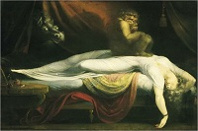
BAKHTAK
Suffer from excruciating nightmares? Ever wake up with a weight on your chest, unable to move or breathe? That may be the work of the Bakhtak, a creepy being of Persian folklore that sits on your chest while you’re sleeping. No one is quite sure why the Bakhtak takes such glee in filling you with bad dreams or causing near-suffocation and sleep paralysis, but we do know the Bakhtak gets around. The Bakhtak of Iranian fame is often depicted as a little goblin-like creature, but the same concept takes on the guise of an Old Hag in English folklore and is similar to the Mara of Scandinavian origin.
Bakhtak weakness and how to protect yourself
As this creature is fictional, the symptoms that leads to its existence is linked to sleep paralysis.
There is no real protection for such a creature if it was real, but meditational training and the understanding of how to wake up during paralysis would be helpful.
Common symptoms that may be linked to of this condition are as follows:
* A feeling of being choked or suffocated
* A feeling of being pinned down or sat upon (particularly in the chest area)
* Auditory hallucinations, typically the sounds of footsteps and voices nearby or knocking or banging on the walls
* Visual hallucinations, typically beings or dark shadows surrounding or standing near the bed
* A frightening feeling of descending or encompassing evil or dread
* Shaking of the body or a rumbling sensation (ringing) in the ears
* A feeling of intense, suffocating evil
* A feeling of being in a dream-like state while at the same time sensing being awake
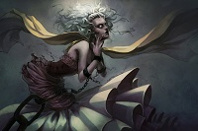
Banshee
The Banshee is a female spirit in Irish mythology , usually seen as an omen of death and a messenger from the Otherworld. The story of the bean-sidhe began as a fairy woman keening at the death of important personages. In later stories, the appearance of the banshee could foretell the death. According to the legend, the banshee can appear in a variety of guises. Most often she appears as an ugly, frightening hag, but can also appear as a stunningly beautiful woman of any age that suits her and is seen washing the blood stained clothes or armour of those who are about to die. Although not always seen, her mourning call is heard, usually at night when someone is about to die and usually around woods.
Banshees were common in Irish and Scottish folk stories such as those written down by Herminie T. Kavanagh. They enjoy the same mythical status in Ireland as fairies and leprechauns. They are also known in German culture as “Washer women” and in France as “Dames blanches”.
The banshee is a solitary creature without male counterpart who never partakes in communal human or fairie social enterprise. When multiple Banshees wail together, it will herald the death of someone very great or holy. The Scottish version of the Banshee is the Bean Nighe.
Banshee weakness and how to protect yourself
Weakness:
- Iron: The banshee may be able to be harmed by cold-forged iron.
- Salt: Salt repels the Banshee, as it is considered to be pure and anathema to the denizens of the spirit world. Any other methods of protecting oneself from the Banshee are unknown at this point.
- Bones: If the Banshee was once human (not all Banshees are ghosts), she may be able to be put to rest by finding her earthly remains, and then salting and burning them.
Protection:
- Both in Great Britain and the United States the belief is if you leave a light on in one room of your home a ghost will never approach it especially if you use lit candles, which are considered a powerful protection.
- A classic belief is if you can call the ghost by their name it will banish them for good.
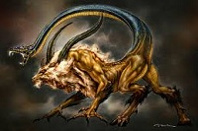
Chimera
The Chimera according to Greek mythology, a monstrous fire-breathing female creature of Lycia in Asia Minor, composed of the parts of three animals: a lion, a serpent and a goat. Usually depicted as a lion, with the head of a goat arising from its back, and a tail that ended in a snake’s head, the Chimera was one of the offspring of Typhon and Echidna and a sibling of such monsters as Cerberus and the Lernaean Hydra.
Not only was the Chimera a scary looking creature, this Greek mythological monster was a dangerous foe in battle. With its ability to breathe fire from the lioness head the Chimera was capable of dangerously hot middle to long distance attacks with its breath. The scorching heat generated by the fire would be hot enough to melt armour and weaponry making the Chimera a hugely dangerous fight to anyone.

Cyclops
In Greek and Roman mythology , a cyclops is a member of a primordial race of giants, each with a single eye in the middle of its forehead. It is a great possibility that people have been mistaken a congenital abnormality called Cyclopia in which the human baby is malformed having only one central eye.
A cyclops (/ˈsaɪklɒps/ SY-klops; Ancient Greek: Κύκλωψ, Kyklōps; plural cyclopes /saɪˈkloʊpiːz/ sy-KLOH-peez; Ancient Greek: Κύκλωπες, Kyklōpes), in Greek mythology and later Roman mythology, was a member of a primordial race of giants, each with a single eye in the center of his forehead. The word “cyclops” literally means “round-eyed” or “circle-eyed”.
Homer does not specifically state that the cyclops, Polyphemus, has only one eye; some scholars suggest this is implied in the passage that describes Odysseus asking his men to cast lots to select a group that will join with him “to lift the stake and grind it into his eye when sweet sleep should come upon him.”However others suggest that Homer’s Polyphemus may have had two eyes. It is pointed out that in the Odyssey when the actual blinding occurs there is a reference to plural brows and lids. Also Homer describes in some detail the entire race of cyclopes, critiquing their agricultural techniques, in what may be literature’s first anthropological study, and never mentions their monocularity. It is also noted that the first artistic or graphic depiction of the blinding episode appears on an amphora that was created by the Polyphemos Painter c. 680-650 B.C., and the artist shows the blinding stake has two prongs, as though two eyes are being targeted. (wikipedia)

Dragon
A dragon is a legendary creature, typically with serpentine or reptilian traits, that features in the myths of many cultures. There are two distinct cultural traditions of dragons: the European dragon, derived from European folk traditions and ultimately related to Greek and Middle Eastern mythologies, and the Chinese dragon, with counterparts in Japan (namely the Japanese dragon), Korea and other East Asian countries.
The two traditions may have evolved separately, but have influenced each other to a certain extent, particularly with the cross-cultural contact of recent centuries. The English word “dragon” derives from Greek δράκων (drákōn), “dragon, serpent of huge size, water-snake”.
How to defend yourself against a dragon
In such an encounter your best bet is to run as fast as your legs can carry you, however if that option is far gone we can look for the weaknesses and glimmer of hope to get away:
The dragons name
knowledge of a dragon’s or human’s true name confers power over them. So by any chance you can guess its name, you shall see another day.
Here are some names from Norse mythology to help you going:
Níðhöggr, an evil dragon who gnaws at the roots of Yggdrasil, the World tree;
Jörmungandr, another evil dragon also known as Miðgarðsormurinn (Icelandic), Midgårdsormen (Swedish and Danish), Midgardsormen (Norwegian), the giant sea serpent which surrounds Miðgarð, the world of mortal men; later to arise out of waters to battle his archenemy Thor at the end of the world.
Fafnir, which had turned into a dragon because of his greed for a ring, and was killed by Sigurd.
Lindworms, usually two-legged serpents of Germanic myth and lore, often interchangeable with dragons;
Landvættur, the benevolent dragon with whom King Harald Bluetooth’s servant met in Vopnafjörður according to Heimskringla, and also depicted on the Icelandic Coat of Arms;The dragon that Beowulf encountered, which mortally injured him.

ElvesElf
An elf is a being of Germanic mythology . The elves were originally thought of as a race of divine or semi-divine beings endowed with magical powers, which they use both for the benefit and the injury of mankind. In pre-Christian mythology, they appear to have been divided into light elves and dark elves, The earliest preserved description of elves comes from Norse mythology that holds that the men could be elevated to the rank of elves after death, Crossbreeding was possible between elves and humans in the Old Norse belief.Words for the nymphs of the Greek were translated to be same as “elves” or its variants by Anglo- Saxon scholars.
Life span
Elves are naturally immortal, and remain unwearied with age. In addition to their immortality, Elves can recover from wounds which would normally kill a mortal Man. However, Elves can be slain, or die of grief and weariness.
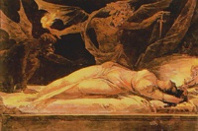
IncubusSuccubus
An incubus is a demon in male form who, according to a number of mythological and legendary traditions, lies upon sleepers, especially women, in order to have sexual intercourse with them. Its female counterpart is the succubus. An incubus may pursue sexual relations with a woman in order to father a child, as in the legend of Merlin. Religious tradition holds that repeated intercourse with an incubus or succubus may result in the deterioration of health, or even death.
In modern representations, a succubus may or may not appear in dreams and is often depicted as a highly attractive seductress or enchantress; whereas, in the past, succubi were generally depicted as frightening and demonic.
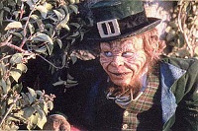
Leperchaun
Leprechauns have been linked to the Tuatha Dé Danann of Irish mythology who are thought to derive from the pre-Christian deities of Ireland. When the surviving stories were written, Ireland had been Christian for centuries, and the Tuatha Dé were represented as mortal kings, queens and heroes of the distant past; however there are many clues to their former divine status. Popular depiction shows leperchauns as being no taller than a small child. The leprechaun is said to be a solitary creature, whose principal occupation is making and mending shoes, and who enjoys practical jokes. According to William Butler Yeats, the great wealth of these fairies comes from the “treasure-crocks, buried of old in war-time”, which they have uncovered and appropriated.According to McAnally the leprechaun is the son of an “evil spirit” and a “degenerate fairy” and is “not wholly good nor wholly evil”.
How to defend yourself against a Leperchaun
Leperchauns are weak for counting salt grains, so all you have to do is to throw some salt close to them. They have a weakness for counting how many there are and during this time you can do a clean getaway.
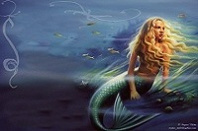
Mermaid
A mermaid is a mythological aquatic creature with a female human head and torso and the tail of a fish..The mermaids have been discussed since at least 5000 BC. Her origins are believed to be from the Great Queen Atargatis, who loved a mortal shepherd and unintentionally killed him. Ashamed, she jumped into a lake to take the form of a fish, but the waters would not conceal her divine beauty. Thereafter, she took the form of a mermaid—human above the waist, fish below. Mermaids were however noted in British folklore as unlucky omens – both foretelling disaster and provoking it. There is a high possibility that people had been confusing them with Sirenias (aquatic animals) or people suffering from a congenital disease Sirenomelia (aka mermaid syndrome in which a child is born with his or her legs fused together).
Sirens
In Greek mythology, the Sirens (Greek singular: Σειρήν Seirēn; Greek plural: Σειρῆνες Seirēnes) were dangerous creatures, who lured nearby sailors with their enchanting music and voices to shipwreck on the rocky coast of their island. Roman poets placed them on some small islands called Sirenum scopuli. In some later, rationalized traditions, the literal geography of the “flowery” island of Anthemoessa, or Anthemusa, is fixed: sometimes on Cape Pelorum and at others in the islands known as the Sirenuse, near Paestum, or in Capreae. All such locations were surrounded by cliffs and rocks.Although a Sophocles fragment makes Phorcys their father, when Sirens are named, they are usually as daughters of the river god Achelous, with Terpsichore, Melpomene, Sterope, or Chthon (the Earth). In Euripides’ play, Helen (167), Helen in her anguish calls upon “Winged maidens, daughters of the Earth.” Although they lured mariners, the Greeks portrayed the Sirens in their “meadow starred with flowers” and not as sea deities. Roman writers linked the Sirens more closely to the sea, as daughters of Phorcys. Sirens are found in many Greek stories, notably in Homer’s Odyssey.
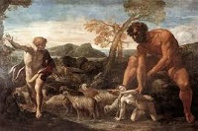
Nephilim
Nephilim are beings, who appear in the Hebrew Bible; specifically mentioned in the Book of Genesis and the Book of Numbers; they are also mentioned in other Biblical texts and in some non-canonical Jewish writings. They were called fallen ones because men’s hearts would fail at the sight of them. Some suggest that they were giants and when they fell, the ground shook, causing others to fall too. They might not be historical figures but ancient imagery with questionable meaning. Some view of them as the hybrid offspring of fallen angels and human women. In Hebrew Bible there is also mention of Rephaites alongside Nephilims, who were an ancient race of giants in Iron Age and were thought to be dead that lurked upon earth.

Ogre
Ogre possibly derived from Oegrus from Greek mythology who was the son of Greek blood shedder god. The word ogre is of French origin . Keeping the Greek myth, Oegrus might have cursed some people to ogres where an ogre is described large, cruel, monstrous and hideous humanoid monster. Also featured in mythology, folklore and fiction. Ogres are often depicted in fairy tales and folklore as feeding on human beings, and have appeared in many classic works of literature. In art, ogres are often depicted with a large head, abundant hair and beard, a voracious appetite, and a strong body. The term is often applied in a metaphorical sense to disgusting persons who exploit, brutalize or devour their victims. The French tale tells of them as habitats of kingdom of Logres [England].
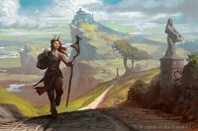
Satyr
Satyrs were originally seen as companions of the goat god Pan in ancient Greek civilization . The first drawings of satyrs were of normal men, though often with an erect phallus. It was later merged with the Roman faun which is when they began to be depicted as half men half goats (the upper body being that of the man, and the lower half being that of a goat). Satyrs are described as roguish but faint-hearted folk — subversive and dangerous, yet shy and cowardly. Many early accounts which apparently refer to this animal describe the males as being sexually aggressive towards human women and towards females of its own species. In old age they are often seen with horns on their head, while young satyrs are seen with nubs instead.

Unicorn
The unicorn is a legendary animal that has been described since antiquity as a beast with a large, pointed, spiraling horn projecting from its forehead. The unicorn was depicted in ancient seals of the Indus Valley Civilization and was mentioned by the ancient Greeks in accounts of natural history by various writers, including Ctesias, Strabo, Pliny the Younger, and Aelian. The Bible also describes an animal, the re’em, which some translations have rendered with the word unicorn.
In European folklore, the unicorn is often depicted as a white horselike or goatlike animal with a long horn and cloven hooves (sometimes a goat’s beard). In the Middle Ages and Renaissance, it was commonly described as an extremely wild woodland creature, a symbol of purity and grace, which could only be captured by a virgin. In the encyclopedias its horn was said to have the power to render poisoned water potable and to heal sickness. In medieval and Renaissance times, the horn of the narwhal was sometimes sold as unicorn horn.
Unicorn horn
A unicorn horn, also known as an alicorn, is a legendary object whose reality may have been accepted in Western Europe throughout the Middle Ages. Many healing powers and antidote’s virtues were attributed to the horn of the unicorn. These properties, assumed real since the 13th century, made it one of the most expensive and most reputable remedies during the Renaissance, and justified its use in royal courts. Beliefs related to the “unicorn horn” influenced alchemy through spagyric medicine. The horn’s purification properties were eventually put to the test in, for example, the book of Ambroise Paré, Discourse on unicorn – marking the beginnings of the experimental method.

Yeti
Yeti or abominable snowman mythological humanoid creature said to inhabit the Himalayan region of Pakistan and Nepal. The scientific community largely regards the Yeti as a legend, yet it remains one of the most famous creatures of cryptozoology parallel to Bigfoot of North America. It is tall, bipedal creature covered with long white hair and wore no clothes. He had an interesting feature of changing his hair color in sunlight to fox red.
The “Abominable Snowman”The appellation “Abominable Snowman” was coined in 1921, the same year Lieutenant-Colonel Charles Howard-Bury led the 1921 British Mount Everest reconnaissance expedition which he chronicled in Mount Everest The Reconnaissance, 1921. In the book, Howard-Bury includes an account of crossing the Lhakpa La at 21,000 ft (6,400 m) where he found footprints that he believed “were probably caused by a large ‘loping’ grey wolf, which in the soft snow formed double tracks rather like a those of a bare-footed man”. He adds that his Sherpa guides “at once volunteered that the tracks must be that of ‘The Wild Man of the Snows’, to which they gave the name ‘metoh-kangmi’. “Metoh” translates as “man-bear” and “Kang-mi” translates as “snowman”.
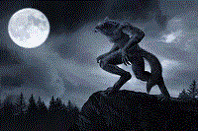
Werewolf
Werewolf is a mythological human with the ability to shapeshift into a wolf or an anthropomorphic wolf-like creature, either purposely, by being bitten or scratched by another werewolf, or after being placed under a curse. This transformation is often associated with the appearance of the full moon. Werewolves are often attributed super-human strength and senses, far beyond those of both wolves or men.
The name Werewolf most likely derives from Old English wer (or were) and wulf. The first part, wer, translates as “man” (in the sense of male human, not the race of humanity). It has cognates in several Germanic languages including Gothic wair, Old High German wer and Old Norse var, as well as in other Indo-European languages, such as Latin vir, Lithuanian vyras and Welsh gwr, which have the same meaning.
Werewolves weakness
Silver
Werewolf dies when scratched with silver, there has to be something running through the wolf that causes it to expire from just a wee sparkle.Silver has a few good qualities. It conducts heat better than any other metal. It’s incredibly ductile and malleable, which is one of the reasons why it’s used for jewelry in the first place. Werewolves are equally malleable — they change shape easily. Although they’re usually found in northern woods on cold, misty nights, they might have a problem with heat, but there has never been any mention of having to heat a silver bullet or knife before it’s shot into a werewolf.
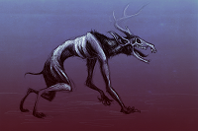
Wendigo
The Wendigo is a creature appearing in the mythology of the Algonquian people. Descriptions of the Wendigo vary across culture, but they are generally described as a large alien-like canine beast. They are malevolent and cannibalistic creatures. Wendigos are strongly associated with the winter, the north, and coldness. Human beings will transform into Wendigos if they perform cannibalism. The person will become possessed by the demonic spirit of the beast, usually in a dream. Once transformed, the individual will become violent and obsessed with eating human flesh. These monsters are the embodiments of gluttony, greed, and excess.
They are never satisfied with killing and consuming one person. Wendigos are constantly searching for new victims. They have been classified as giants and upon transformation the human will grow considerably in size. They populate rural and highly forested, mountainous regions. Recently the Wendigo has become a horror entity, much like the vampire, werewolf, or zombie.
